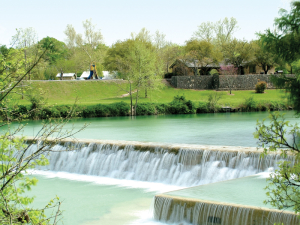City of Blanco
Do you have any new information, corrections, photos, or more about this entry? Contact us today to help record Blanco's history.
The Blanco area was first settled in 1853 by Texas Ranger James Hughes Callahan, Eli Clemens Hinds, and their families. Captain James Callahan had first visited the Blanco Valley years earlier and decided to return to the area. The pioneers built homes along the Blanco River and, in 1854, formed the Pittsburg Land Company with General John D. Pitts and others.
The company laid out the town of Pittsburg across the Blanco River from present-day Blanco. When Blanco County was formed in 1858, about 120 acres of land left to the Land Company in Captain James Callahan’s will was used to establish the city of Blanco for the county’s seat.
The historic courthouse on the town square, the third courthouse built in town, was completed in 1886. The creation of new counties south of Blanco changed the shape of this county. The courthouse served only four years as the courthouse before an election moved the county seat to the more central Johnson City in 1890.
Blanco is primarily a farming and ranching town. Cotton and sheep were first brought in by Eli Hinds. As with many small towns, tourism has become a major part of the economy. Thanks to the local climate, lavender grows well and Blanco is host to the official lavender festival of Texas.
The town square, and the Old Blanco County Courthouse, form the center of town and a perfect place to walk around.
Building a Town
In 1885, early Blanco historian John W. Speer summed up local history this way:
Prior to the year 1854, this was the undisputed domain of the buffalo, mustang, black bear, panther, Mexican lion, and almost all kinds of small game. Also, the red man had It for his hunting ground If not for his wigwams, and these fertile valleys, limpid streams, and picturesque mountains were seldom seen by white men.
Spanish explorers were the first Europeans to visit the area; In 1721, the Marqués de San Miguel de Aguayo named the Blanco River (Rio Blanco or White River), presumably because the river, fed by sparkling springs, was cradled in a bed of white limestone. Plans to establish a Spanish mission here in 1753 did not materialize when the mission was built on the San Saba to the north.
The town spring was dug out of the rocks by the Indians. It is said that in the early days, Native Americans burned off the land each year, leaving very few large trees.
In 1835, Horace Eggleston obtained title to a league of land on Martin’s Fork (the site of present-day Blanco) from the state of Cohuila and Texas. Soon after he died in early 1853, his widow Sarah Ann sold half of the property to five men operating as the Pittsburg Land Company, including Captain James Callahan, who was already residing at Martin’s Fork. (Callahan et al. acquired the rest of the land in 1856.)
Callahan, Eli C. Hinds, and "Uncle" Billie Trainer were the first three heads of families to settle on the property in the spring of 1853, building cabins on both sides of the river. In the same year, seven more families came, increasing the total to ten. In 1855, the Pittsburg Land Company began offering lots for sale in a new town they established called Pittsburg on the south bank opposite present-day Blanco. Named for one of their members, John D. Pitts, Pittsburg was at the time within northwestern Comal County.
Shelter to keep themselves, their gunpowder, and their food dry was the most pressing need of these pioneer families, according to Speer. They cared for their stock, started farms, planted orchards, and constantly feared Indian attacks. They had to make long journeys to San Marcos for mail and to New Braunfels to mill, which took four or five days with teams of oxen. They also had to go to these towns to purchase timber, powder, lead, caps, tobacco, coffee, and sugar, though, as Speers says, they didn't need much sugar because they had plenty of wild bee honey available locally, along with bear meat and venison. According to Speer, these "old timers"
failed to lay by large estates for themselves….[What] they sowed, we reap; they planted, we eat the fruits, they subdued: we enjoy this beautiful, healthful, happy land.
Located on Highway 281 on the Edward's Plateau 47 miles west of Austin and 47 miles north of San Antonio, this "beautiful, healthful, happy land" supports a variety of vegetation. Post oak, live oak, cypress, cedar, and pecan trees and various species of cacti, native grasses, and grapevines can be found In the Blanco area.
The act creating Blanco County on February 12, 1858, specified that the county seat, as well as the county, be called Blanco and be located within five miles of the county's geographic center. A new town site for the county seat was selected on the north bank of the river, on higher, less flood-prone land donated by the Pittsburg Land Company, and Blanco was born.
Of interest is the gridiron plan arranged around a courthouse square mapped out for the new town. According to the historic district survey conducted for the National Register of Historic Places, this plan is sometimes referred to as a Shelbyville plan…prevalent in Anglo-American communities in East and Central Texas and strikingly different from the more linear plans found in the nearby German communities of the Hill Country.
Although in 1862, newly created Kendall County claimed the entire southwestern half of Blanco County, leaving Blanco no longer in the center of the country, the fact that the county's population was concentrated in the south resulted in little pressure to move the county seat from Blanco.
By 1870, thanks to its status as the county seat, Blanco had outstripped Pittsburg, boasting three stores, a hotel, a church, and two cotton gins. A decade later, Blanco had four general merchandise stores; a drugstore, meat market, furniture store, saloon, flouring and grist mill, and wagon maker; two grocery stores, saddlery shops, and schools; several nearby gins; and a population of about 300. In 1885-1886, the fine new two-story stone courthouse was at last built, completing the original town plan.
But in January 1890, disaster struck when by a narrow vote the county seat was moved to Johnson City, fourteen miles to the north, drastically slowing Blanco's economic growth, which didn't recover until the renewed prosperity of the first decade of the 20th century.
Agriculture and ranching have been the main occupations in the Blanco vicinity. Sheep raising, which began in the area in 1859, flourished alongside cattle ranching. Cotton began to be grown in 1866 and became one of the main money-makers in the area. By 1870, cotton and grain gins had been built up and down the river as well as one in Blanco. This agricultural activity, linked directly to the available natural resources, very much influenced the appearance of early Blanco.
Extensive deposits of Cap Mountain limestone constituted another important natural resource. This limestone was a common material in older buildings. One can imagine old Blanco from a distance appearing to literally grow out of the earth.
Native limestone, rough coursed and smooth, was the preferred material for foundations, load-bearing walls, and façade facings on buildings from the 1860s to the 1940s, including the new courthouse, completed in 1886. This fact, added to the city's gridiron plan with the courthouse building as a focal point, gives Blanco an uncommon visual unity.
Blanco sits at the south end of the Heartland Region with its historic district recorded in the National Register of Historic Places. Of the 46 properties in the district, over half retain a high degree of architectural integrity and date to 1941 or before.
Surrounding the Old Blanco County Courthouse on the square are largely one-story residential, commercial, and governmental properties. A variety of stylistic influences and architectural forms are represented in the district as well as periods of development from the mid-19th century to the present. The west side of the square best represents the architectural diversity as well as the best commercial row. While brick appeared in buildings in the '20s and '30s and concrete block in the '40s, nevertheless the visual coherence of the district through the use of natural materials such as limestone has been maintained with few exceptions.
The Blanco Historical Commission encourages you to visit each of the sites highlighted in the district.


